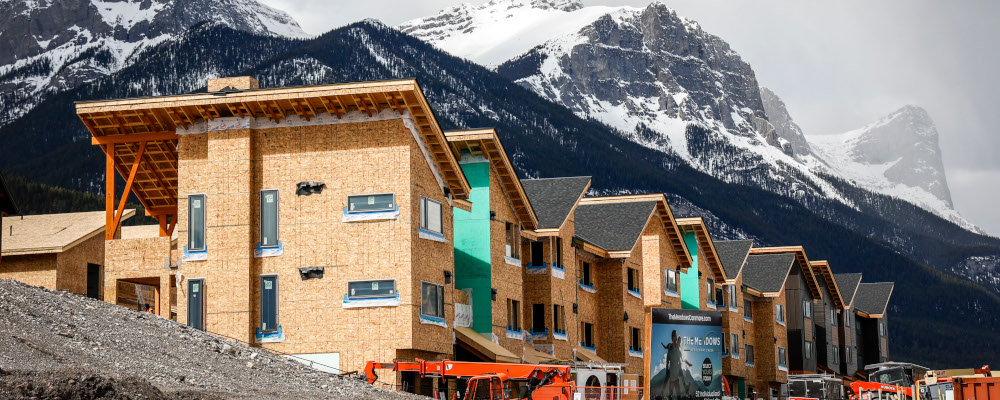A war-time-like effort is needed for Canada to build the 5.8 million homes the Canadian Mortgage and Housing Corporation (CMHC) estimates need to be built by the end of 2030 to restore affordability. This goal can only be achieved through a robust industrial strategy, as a “more of the same” strategy is doomed to fail in at least three different ways.
The first failure point is speed. The CMHC target requires Canada to triple homebuilding in a short period, and we cannot scale that construction sector that quickly without innovation. The second is labour shortages. Canada needs a robust housing workforce strategy to increase the talent pool from electricians to urban planners, but that will not be sufficient. Housing construction must experience rapid productivity increases. The third is climate change. Simply tripling what we are doing now will not be compatible with Canada’s climate targets due to emissions from construction and land-use changes. Furthermore, we must ensure that what gets built is resilient to a changing climate.
A federal industrial strategy can address all of these by changing what we build and how we build to make the process faster, less labour-intensive, and more climate-friendly. The government can begin by curating a list of climate-friendly, less-labour-intensive building methods that exist today in Canada but need support and expansion financing to grow, such as mass timber, modular homes, panelization, and 3D printed homes.
Next, a strategy is needed to create a market for these technologies. The CMHC can facilitate this by creating a free catalogue of designs as they did in the 1940s. This catalogue would include designs for various housing types incorporating these technologies, from midrise apartment buildings to student residences, with diverse designs appropriate for different climate conditions. Builders using these designs could be fast-tracked for regulatory approvals, such as ones from the CMHC, since the building design had already been approved.
Government can act as the first customer for these projects, further accelerating uptake. It can build homes to address the estimated 4,500-unit shortage for Canadian Armed Forces families. Social housing can be built with the use of an acquisition fund. Colleges and universities should be given funding and instructed to build on-campus student housing to support a rapidly growing population of international students or risk losing their status as designated learning institutions, which would eliminate their ability to bring in those international students.
Tweaks to the tax system will be needed to help make these projects viable, from removing the HST on purpose-built rental construction to reintroducing accelerated capital cost provisions. The approvals process at all orders of government must be streamlined, and agencies must be staffed up to address backlogs, such as in the CMHC’s MLI Select program. Building codes will need to be amended to be compatible with these technologies, and zoning codes will need to be amended to allow for more as-of-right construction, such as in New Zealand, where six-story apartment buildings are permissible as-of-right within 800 metres of any transit station.
The federal government cannot alter municipal zoning codes, but it can offer incentives to do so. It could set up a set of minimum standards (call it a National Zoning Code), and any municipality that altered its zoning code to be compliant could be given one-time per-capita funding to spend on infrastructure construction and maintenance, no other strings attached. For example, a $200 per-capita fund would give the City of Toronto an additional $600 million to upgrade infrastructure and cost the federal government a maximum of $8 billion should every municipality in Canada sign-up. It could also follow Australia’s lead, which is giving states an extra $15,000 for every home built over a target. These incentives would not only cause provinces and municipalities to approve more homes, but they would also give them the infrastructure funding holding up current homebuilding.

We should view this strategy as an investment, not a cost, as the economic opportunities are enormous. New housing will allow workers to live closer to opportunities, and scaling up these technologies creates manufacturing jobs across Canada and new products to export worldwide.
The key to this industrial strategy working is speed. The federal government must avoid setting up new approvals processes and micromanaging the system. Instead, it should set straightforward standards, and as long as those standards are met, approvals should be granted and payments made. New infrastructure funding to municipalities should not be on a project application basis, as it slows the process, and cities know best what they need.
We are in a crisis, and a war-time-like effort is needed. The federal government must prioritize speed and act now.
Recommended for You

The Notebook by Theo Argitis: Carney’s One Big Beautiful Tax Cut, and fresh budget lessons from the U.K.

Christopher Snook: Is Canada sleepwalking into dystopia?

Rudyard Griffiths and Sean Speer: The fiscal hangover from the One Big Beautiful Bill hits Canada

‘A fiscal headache for Mark Carney’: The Roundtable on how Trump’s One Big Beautiful Bill could affect Canada




